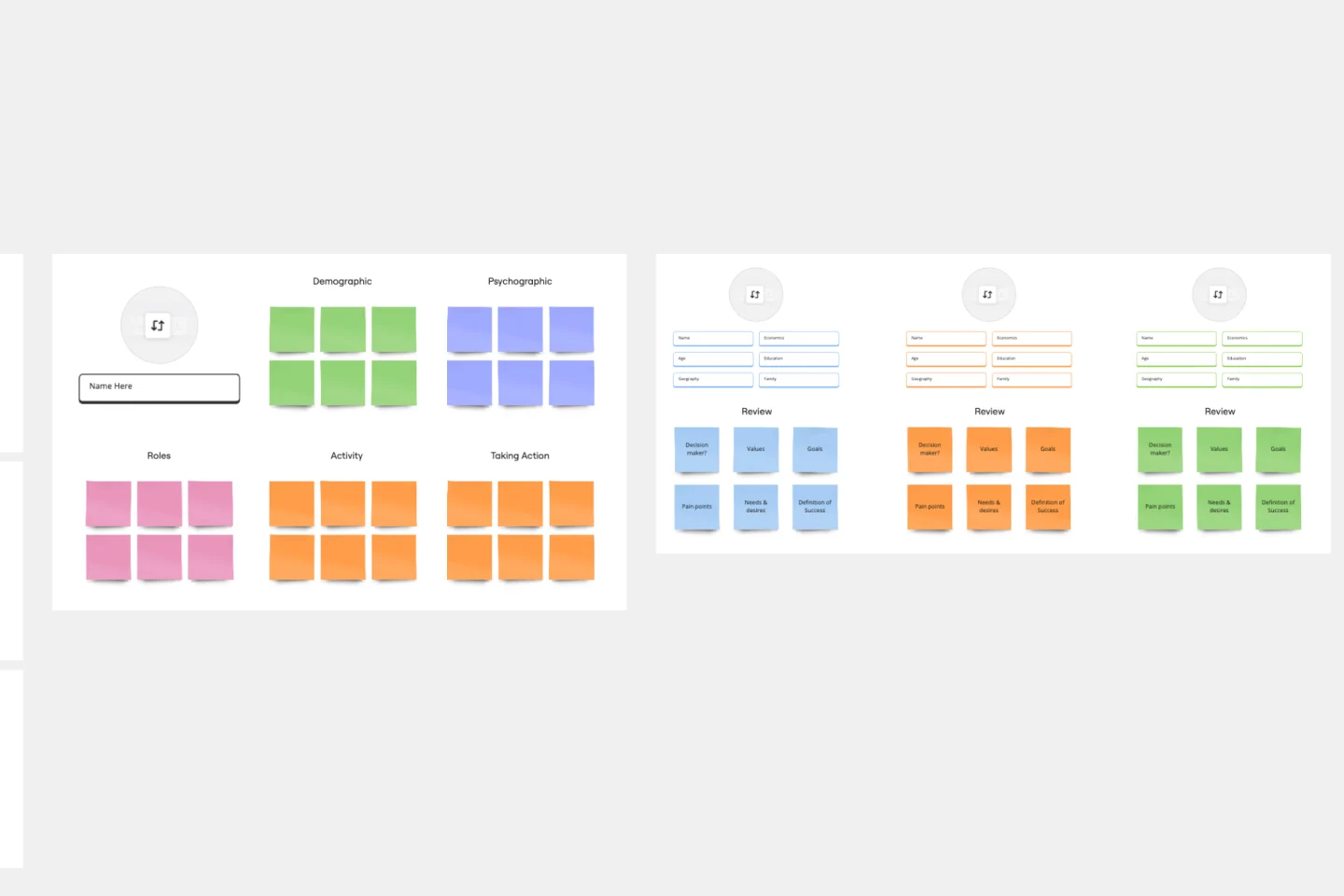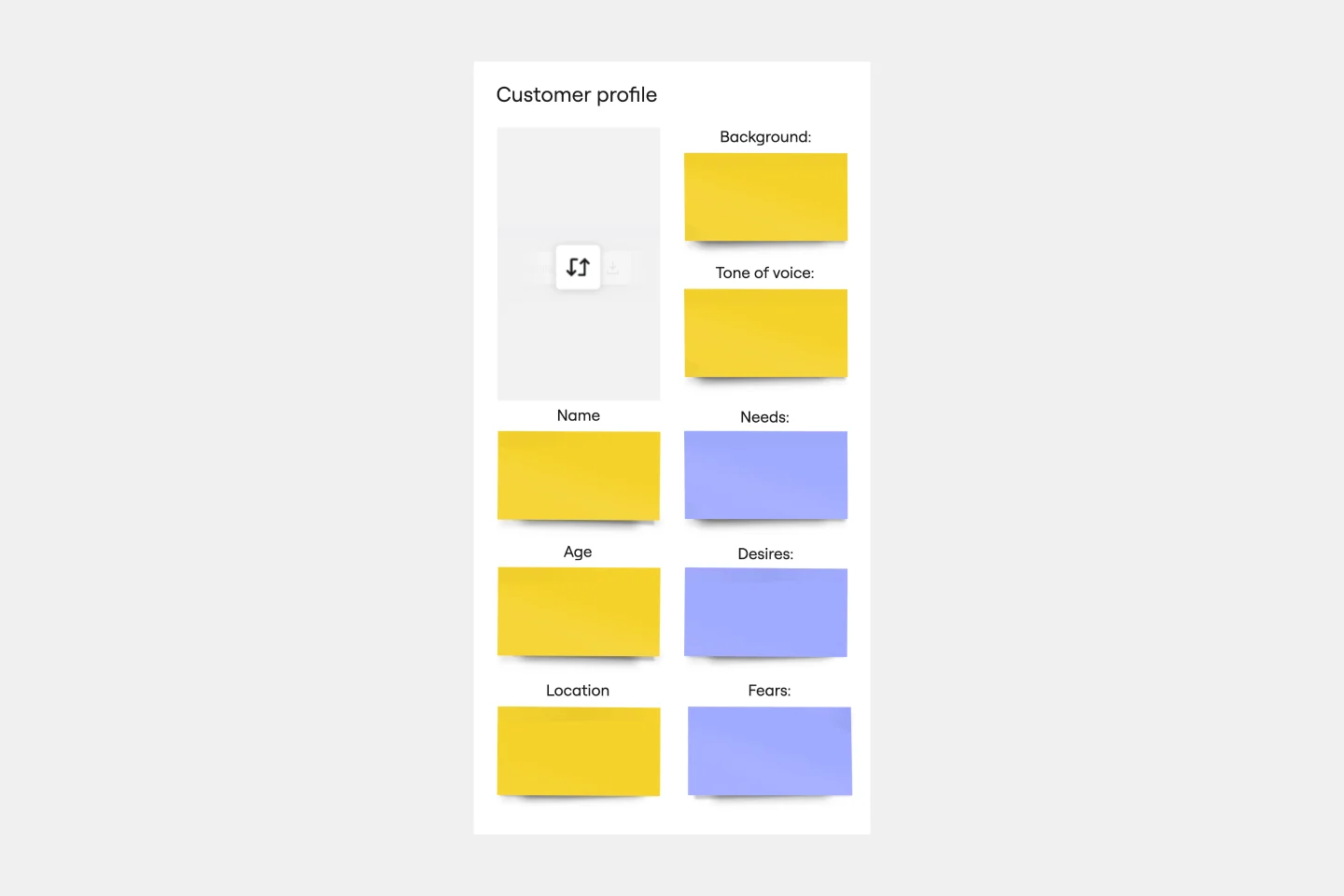About the Audience Persona Template
Crafting messages that resonate with your audience and providing services or products that delight them is essential to the success of any business. An audience persona template is a crucial tool marketers, UX designers, and content creators must use to visualize and communicate with their target audience. It helps teams get a clear picture of their ideal customer, ensuring everyone is on the same page when making strategic decisions.
Here's a breakdown of the areas included in the template:
Background: This section covers the person's career and educational history, as well as their lifestyle and family setup.
Hobbies and interests: Outline here the person's favorite pastimes, entertainment choices, and interests that occupy their free time.
Goals: Explain the person's career aspirations and life ambitions, as well as their daily objectives and long-term plans.
Biggest fears: Cover the person's personal and professional anxieties and perceived risks in new ventures or changes.
Challenges: This section describes the day-to-day hurdles and overarching life obstacles the person faces and any issues they may face within their industry or personal life.
Common objections: This section lists a person's typical reservations or doubts when making decisions and the frequent hindrances they anticipate in solutions or offers.
Demographics: This section provides information about the person's age, gender, location, income bracket, and other relevant statistical data.
Using these sections, the template helps create a detailed profile that covers all the essential aspects of the audience's identity and outlook, which is crucial for effective and empathetic audience engagement.
How to use the audience persona template
To use the audience persona template in the workspace, follow these steps:
Click to edit each section directly—no need for complex tools or processes.
Drag and drop artifacts—such as images, links, or documents—onto the board to enrich the persona with more context.
Collaborate in real-time with team members, who can also add their insights with just a few clicks.
Why should you use an audience persona template?
Opting for an audience persona template brings many advantages. Here are five key benefits:
Alignment across teams: It promotes a shared understanding of the target audience among cross-functional teams.
Enhanced focus: It ensures that strategies and initiatives remain user-centered by consistently prioritizing the audience's perspective.
Better targeting: It helps to refine marketing and product development efforts to align better with the audience's needs and wants.
Increased empathy: It allows teams to develop a deeper emotional connection with the audience, leading to more empathetic communication.
Data-driven decisions: It transforms abstract data into tangible profiles, which assists in making informed decisions.
Discover more target audience examples and understand your customers better.
Audience Persona Template FAQs
Can the audience persona template accommodate multiple personas?
Absolutely. The template can be duplicated and customized for as many personas as needed to represent different segments of the target audience.
Is it possible to share the persona template with external stakeholders?
Yes, the finished persona can be shared with external stakeholders through a shareable link, ensuring everyone can access the audience's insights.
How detailed should each section of the template be?
It depends on the depth of information available and the project's needs. Generally, the more detailed each section is, the better the understanding of the persona.

Miro
Your virtual workspace for innovation
Miro is an innovation workspace designed for teams of every size, everywhere, to dream, design, and build the future together. Our mission? To empower these teams to create the next big thing, powered by AI at every step of the way. Over 90 million users around the world rely on Miro to untangle complex ideas, put customer needs first, and deliver products and services faster. All supported by best-in-class security, compliance, and scalability.
Categories
Similar templates
Target Audience Template

Target Audience Template
Understanding your target audience is vital to business success. How can you market yourself effectively if you don’t know who you’re targeting? Using the Target Audience template, you can review valuable data about who your customers are and what they want from your product or service.
Buyer Persona Template

Buyer Persona Template
You have an ideal customer: The group (or few groups) of people who will buy and love your product or service. But to reach that ideal customer, your entire team or company has to align on who that is. Buyer personas give you a simple but creative way to get that done. These semi-fictional representations of your current and potential customers can help you shape your product offering, weed out the “bad apples,” and tailor your marketing strategies for serious success.
Draw Your Character

Draw Your Character
Transform the traditional meeting introduction rounds with a Character Drawing Template. Ask people to draw themselves and have some fun.
Proto Persona Template

Proto Persona Template
The Proto Persona Template is tailored to capture the essence of hypothetical user segments. It encapsulates key attributes such as user needs, behaviors, and potential pain points. One of its standout benefits is its ability to foster empathy. By visualizing and understanding these preliminary user profiles, design and strategy teams can tap into a deeper connection with their target audience, ensuring that solutions resonate authentically and address genuine needs.
User Persona Template

User Persona Template
A user persona is a tool for representing and summarizing a target audience for your product or service that you have researched or observed. Whether you’re in content marketing, product marketing, design, or sales, you operate with a target in mind. Maybe it’s your customer or prospect. Maybe it’s someone who will benefit from your product or service. Usually, it’s a whole collection of personalities and needs that intersect in interesting ways. By distilling your knowledge about a user, you create a model for the person you hope to target: this is a persona.
Personas Workshop
Target Audience Template

Target Audience Template
Understanding your target audience is vital to business success. How can you market yourself effectively if you don’t know who you’re targeting? Using the Target Audience template, you can review valuable data about who your customers are and what they want from your product or service.
Buyer Persona Template

Buyer Persona Template
You have an ideal customer: The group (or few groups) of people who will buy and love your product or service. But to reach that ideal customer, your entire team or company has to align on who that is. Buyer personas give you a simple but creative way to get that done. These semi-fictional representations of your current and potential customers can help you shape your product offering, weed out the “bad apples,” and tailor your marketing strategies for serious success.
Draw Your Character

Draw Your Character
Transform the traditional meeting introduction rounds with a Character Drawing Template. Ask people to draw themselves and have some fun.
Proto Persona Template

Proto Persona Template
The Proto Persona Template is tailored to capture the essence of hypothetical user segments. It encapsulates key attributes such as user needs, behaviors, and potential pain points. One of its standout benefits is its ability to foster empathy. By visualizing and understanding these preliminary user profiles, design and strategy teams can tap into a deeper connection with their target audience, ensuring that solutions resonate authentically and address genuine needs.
User Persona Template

User Persona Template
A user persona is a tool for representing and summarizing a target audience for your product or service that you have researched or observed. Whether you’re in content marketing, product marketing, design, or sales, you operate with a target in mind. Maybe it’s your customer or prospect. Maybe it’s someone who will benefit from your product or service. Usually, it’s a whole collection of personalities and needs that intersect in interesting ways. By distilling your knowledge about a user, you create a model for the person you hope to target: this is a persona.
